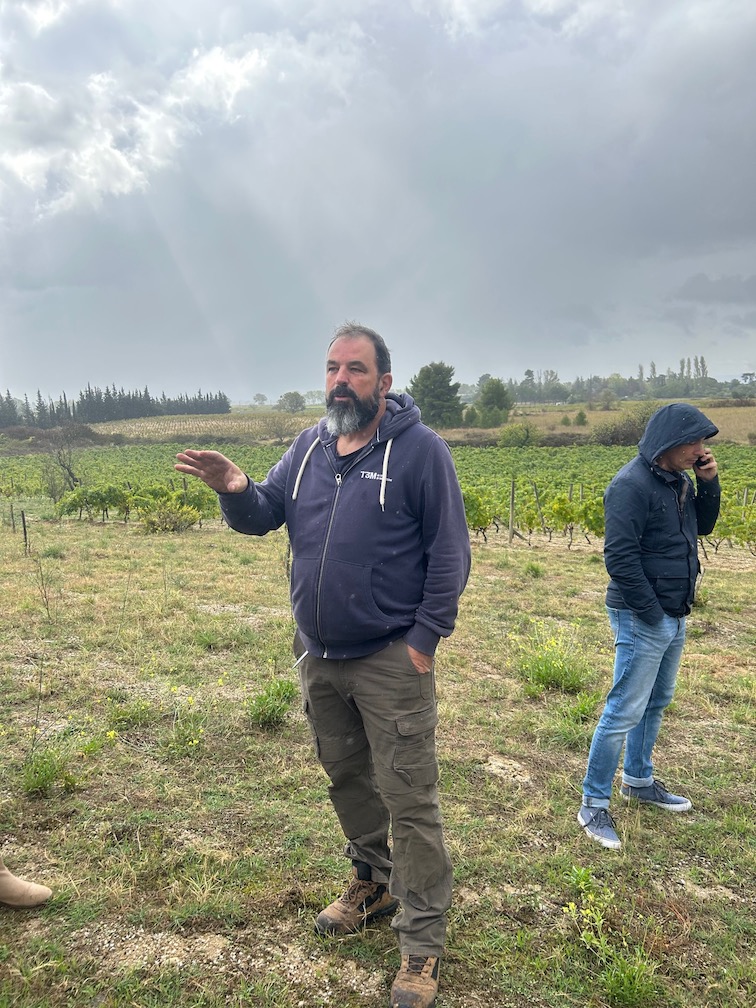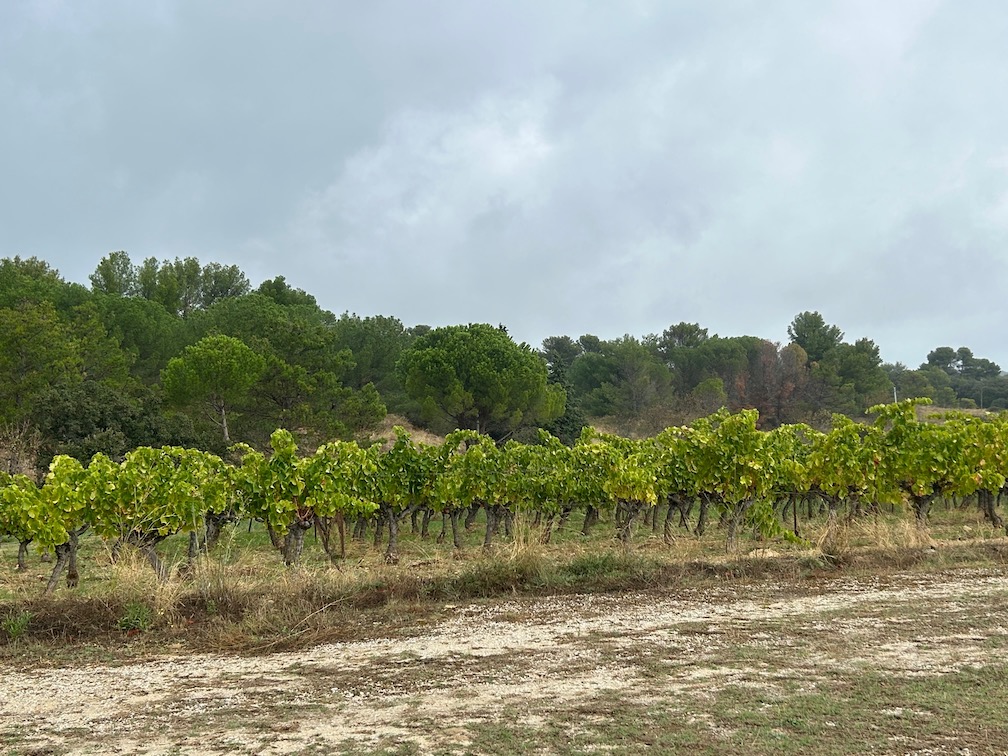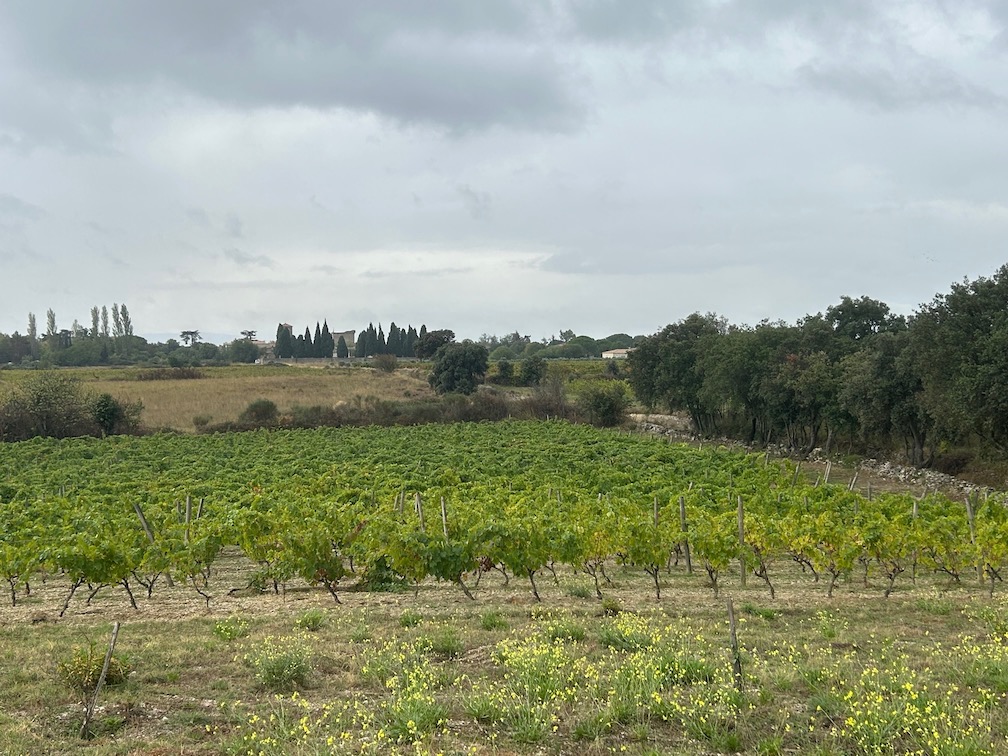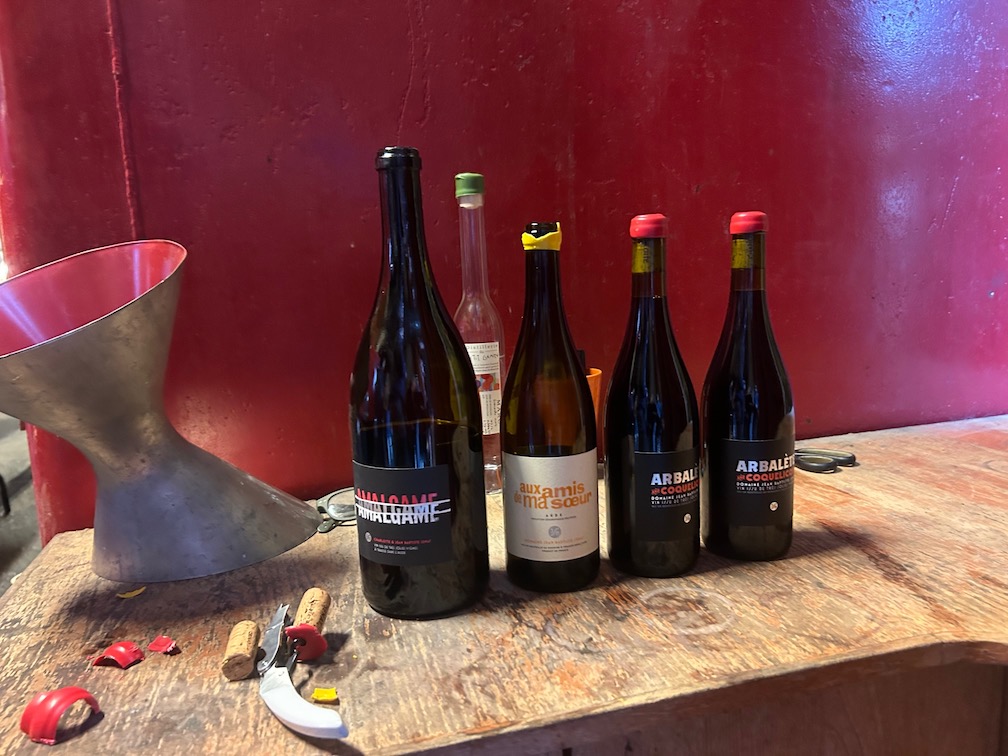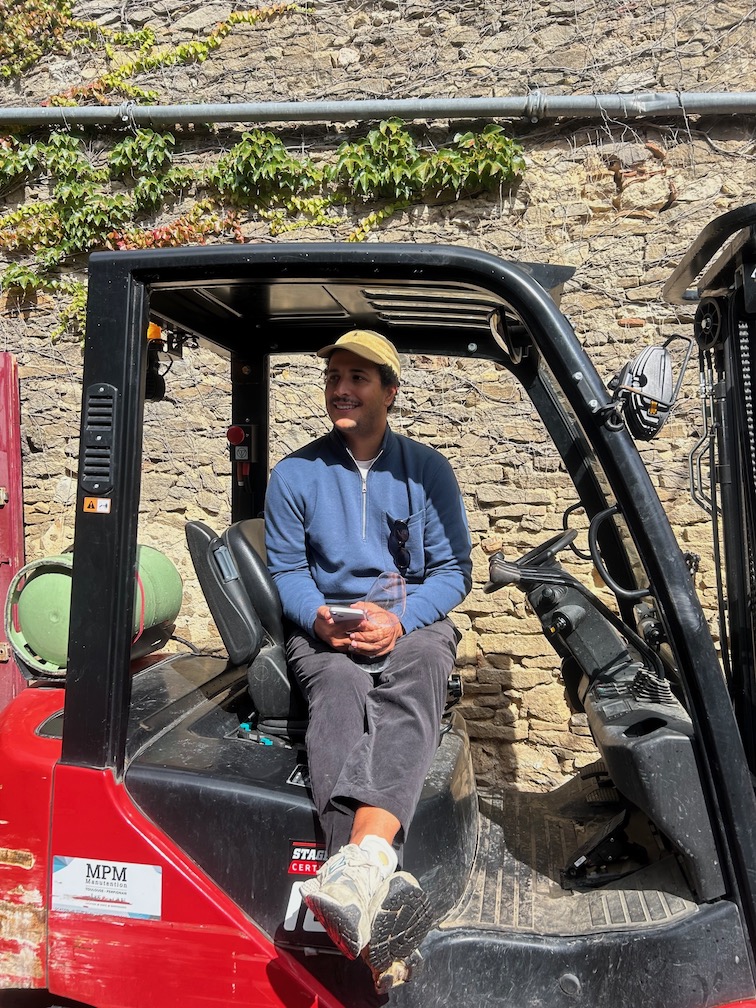Getting on Minerves
Our final Pyrenee visit in Southern France was to Domaine Jean-Baptiste Senat, located in Trausse-Minervois, a rural commune in the Aude Department. Trausse is part of the wider Minervois region which straddles the Aude and the Hérault.
The wine appellation itself sits to the north of the famous Canal du Midi, stretching from Carcassonne to Narbonne. The region is one of the more famous sub-regions of the Languedoc, holding official AOC status since 1985.
The appellation spans across approximately 3,400 ha, with 140,000 hl produced annually. Minervois wine tends to be full-bodied and made from Med grape varieties such as Grenache, Syrah and Carignan, usually in various blends. It is made up of many small, independent wine growers who specialise in making intimate productions of high quality, low yield wines. The wine region lies parallel within a large valley with Montagne Noir to the north and the Pyrenees to the south. This is an area of great natural beauty with many picturesque villages and scenic landscapes. And more garrigue than you can chew.
Minervois takes its name from Minerve, a village forty kilometres from the Mediterranean coast and surrounded by the southern French foothills. The village, in turn, is named after the Greek goddess Minerva.
But human history goes back much further still in the Minervois region. Local cave paintings and fossilized footprints confirm human presence here more than 8000 years ago.
The town’s wine history is also impressively long. Archaeological evidence shows that viticulture here dates back to early-Roman or even pre-Roman times. The wines of the region are also mentioned by Roman historian Pliny the Younger and the writer Cicero.
Viticulture continued here for centuries, expanding further in the late 17th and early 18th Century with the opening of the Canal du Midi and the attendant expansion in trade. A similar effect was produced by the arrival of railway in the 19th Century.
However, with the turn of the 19th Century and the early years of the 20th Century, the wider Languedoc underwent a period of crisis due to overproduction, the phylloxera mildew blights, increased competition from wine imports from French colonies in North Africa and chaptalization in cooler regions of France as well as the growing use of “unknown” wine from the south of France bulking out thinner produce from more high-profile regions.
This culminated in major unrest in the region with sizeable protests against fraud and a fatal government crackdown. The unrest, generally known as the Revolt of the Languedoc winegrowers was a major precursor to the establishment of the appellations system two decades later.
A Defence Union of Minervois winegrowers was formed in 1922 with the region being granted its VDQS title in 1955. Minervois became an appellation 30 years later, in February 1985.
Since the Minervois appellation was granted, the local wines have changed dramatically, garnering praise from critics in France and abroad. As with many French appellations, this increase in quality is due to significant investments in winery equipment and improved vineyard management.
Les Caves has worked with a host of Minervois producers in the past. Some gravitated towards a New World style of extractive winemaking, whilst others favoured an approach which delivered carbonic maceration wines without distinctive character. We’ve always hankered to work with a grower who exalts freshness and subtlety – even from this warm climate region.
Moving to Trausse-Minervois from Paris in 1995 was the result of Jean-Baptiste Senat’s decision to return to his (mother’s) family roots and (re)ignite a latent interest in winemaking. The following year he made his first vintage, equipped the winery, and embarked on his wine journey of discovery (and self-discovery).
He met some talented vignerons who shared their knowledge and read Jules Chauvet’s books which helped him visualize the kind of wine he wanted to make: namely, a natural wine, which in turn led him to immediately adopt organic farming practices. (The domaine is certified.)
Jean-Baptiste now works in the vineyards and in the winery, his wife, Charlotte, in charge of administrative and commercial aspects of the business. Their vigneron life follows the rhythm of the seasons: the intense periods like harvest or the more reflective times like pruning, while the next vintage is in process.
The wines have evolved over the years, but they have remained faithful to the original precepts of natural wine. They only use grape varieties with a strong Mediterranean identity. Grenache is at the heart of most cuvées, combined variously with other grapes, and gentle vinification allows each respective wine to express its own style. All the wines share the quality of drinkability.
With a minimal-interventionist approach, Jean-Baptiste likes wines without trickery. Beauty and authenticity are paramount. The permanent quest for maturity and freshness in the wines requires rigour and focus during the harvest, especially in view of climate change with attendant warmer temperatures and scarce rainfall. Without irrigation, the vines can become stressed, particularly the older vines of Carignan.
The vines grow on two different terroirs: clay-limestone soil and rocky garrigue siliceous-inflected ones. At the base of the foothills of the Black Mountain, the vines are spread over a seven-mile radius throughout different villages, and the Senats believe that the microclimates have more impact on them than the actual composition of the soil and subsoil.
With this in mind, equilibrium in these Minervois wines is achieved by blending complementary varieties from different vineyard locations. Neither alcohol nor extraction are sought; the wines are more like infusions in style, balancing generosity with freshness. Interestingly, Jean-Baptiste is planting more of the “mal-aimés” grape varieties such as Piquepoul Noir, Counoise & Terret Noir which, with their thinner skins and lighter alcohol, help to mitigate the power of the Grenache, Syrah and Carignan, and endow the wines a certain levity and liveliness.
This is most apparent in a delightful new light red called Amalgame, a blend of Grenache Noir 40% Grenache Gris 30% Piquepoul Noir 10% Counoise 10% and Terret Noir 10%. The Grenache Noir is from 30-year-old-vines, but the last three varieties were only planted recently. This field blend is co-fermented whole cluster (hence amalgame) for ten days in tank and bottled early the following year. They describe it as “a wine of coolness, which is floral and slightly tannic. Is it a pale red or a dark rosé…regardless, it’s the perfect companion to anything”. Well, you had me at Piquepoul Noir. Such grape blends assist in the quest for drinkability – we see similar ideas embraced by John and Nicole Bojanowski in Clos du Gravillas with their treasure trove of forgotten varieties vinified singly or forming blends, and also in the wines of Thierry Navarre in Saint-Chinian and most particularly with Domaine Pierre Cros with his plethora of cuvées made from Aramon, Morrastel, Ribeyrenc and the aforementioned Piquepoul Noir.
Arbalète & Coquelicots, two nods and a wink to Guns ‘n’ Roses, is mainly Grenache from clay-limestone and some Syrah for backbone. Also whole cluster ferment in stainless tank, aged on the fine lees, and bottled after a few months without filtration, fining or added sulphites. A pleasure red, silky, unassuming, and very moreish.
Minervois La Nine is a beautiful red wine, illustrating how less can be more. A blend of Carignan from 110-year-old vines (40%), Grenache Noir (60 years-old) and Syrah, this wine undergoes longer elevage and sees a portion of old barrel in its maturation. Bottled on a fruit day, La Nine (which means “the little one” or “the sweetheart”) is a wine that the Senats have been making for twenty years and is a classic Languedoc blend infused with subtle garrigue scents and enchanting spice notes.
The name of the last red wine we try – Mais Ou est Donc Ornicar – originates from an obscure French grammar word play, a phonetic combination of the seven coordinating conjunctions in the French language: mais (but), ou (or), et (and), donc (therefore), or (however), ni (nor), and car (for). Where is Ornicar, then? In the glass, surely! (The Knights who say Ni! might have an alternative explanation).
In this example, Grenache is conjoined with Carignan (vieilles vignes) and Mourvèdre, fermented naturally in barrels and bottled as per usual with nothing added. This cuvée is all about finesse. It’s complex, fruity and mature, round and lively, all at once. The nose opens with notes of liquorice and black fruits, with a certain animal note, before segueing into a palate that is fresh and lifted and very satisfying.
Finally, I should mention the domaine’s sole white wine: Aux Amis de Ma Soeur, a Catalan-Limousin mash-up of Grenache Gris, Grenache Blanc and Chenin from very low yields. Fleshy white fruit aromas and garrigue herbs from the Grenache Blanc, citrus from the Gris and a punch of acidity from the Chenin give this wine its charming personality.
We are fed a lunch of mountains of ace charcuterie, crudités, cheese and excellent bread – washed down with copious wine and bookended with shots of marc.
I reflected that Domaine J-B Senat makes consistently good wines from organically-farmed vines without any additions in the winery, and that yes, it requires precision in the vineyard, in the selection of the grapes and the winemaking, but surely isn’t this the way all wine should be made? Critics of natural wine caricature the vignerons as devotees of the pagan goddess of laissez-faire (i.e. leaving all to chance), when the real truth is that being in tune with your vines and your wines means that you have the greatest appreciation of the whole process of winemaking from pruning to popping in the final cork. In other words, you are always on top of the wines for as long as it takes, rather than looking for shortcuts and easy solutions.
The proof is always in the tasting. The wines always reflect the character of the region and vineyards, the nature of the vintage and the hundreds of individual choices made over the course of the year (or however many years it takes to make a particular wine). We taste it in the wines of Dominique Hauvette, mineral and shimmering like the precious stone names that adorn the labels of various cuvées, in the strong yet liberated and relaxed wines of Mas Foulaquier, in the finesse and elegance of Daumas-Gassac reds and whites as they capture the myriad nuances of their extraordinary terroirs, and in the urgent drinkability of the Senat wines. For all their diverse pleasures, the wines are the result of superb organic and biodynamic farming, fastidious selection of grapes, and careful and responsive winemaking. Other common ingredients are the varieties themselves, limestone-clay (in many cases) and, of course, lots of sunshine. The resultant wines have a Mediterranean je ne sais quoi with textures of ripe (but not overripe) fruits, herbal inflections – the garrigue imprint if you will – fugitive notes of spice, and, despite the warm climate, natural acidity to provide balance.
Now when I drink the wines, I will think of the actual place they come from, rather than try to imagine what that place might look like. And I will treat the non-Picpoul-and-oyster epiphany as delayed gratification!
*
Interested in finding out more about the wines of Jean-Baptise Senat? Contact us directly:
shop@lescaves.co.uk | sales@lescaves.co.uk | 01483 538820


